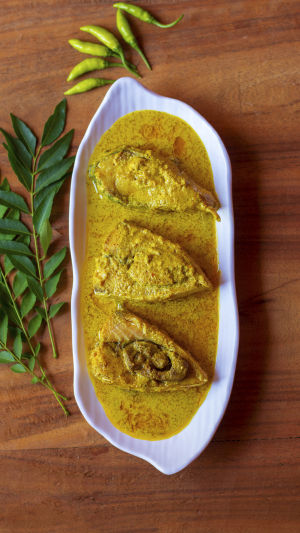Dear Lykkers! Shorshe Ilish, or Hilsa in Mustard Sauce, is one of the most beloved dishes in Bengali cuisine.
This iconic recipe combines fresh hilsa fish with a flavorful mustard paste, creating a culinary experience that is rich in aroma, taste, and tradition.
With its delicate balance of spice and texture, Shorshe Ilish holds a cherished place in Bengali households, especially during monsoon season, when the hilsa is at its freshest.
<h3>The Story Behind Shorshe Ilish:</h3>
Ilish (Hilsa) is more than just a fish for Bengalis—it's an emotion, a celebration of the senses. The monsoon rains bring the peak season for Hilsa, and families eagerly await this time to prepare Shorshe Ilish.
The recipe represents a harmony of Bengali flavors, where mustard provides a sharp, pungent bite, perfectly complemented by the delicate, flaky texture of the hilsa. Traditionally, Shorshe Ilish is served with steamed rice, making it a wholesome and flavorful meal that has been loved for generations.
<h3>Ingredients for Shorshe Ilish:</h3>
To create an authentic Shorshe Ilish, each ingredient plays an essential role in bringing out the dish's rich flavors. Here's what you'll need:
Fresh hilsa fish (cut into pieces) - 500g
Mustard seeds - 3 tbsp (a mix of black and yellow mustard seeds works best)
Green chilies - 4-5 (to taste)
Turmeric powder - 1 tsp
Red chili powder - 1/2 tsp (optional, for a bit of heat)
Salt - to taste
Mustard oil - 3-4 tbsp
Water - 1 cup
Master the Art of Cooking Shorshe Ilish: A Bitter-Free Recipe
Video by Banglar Rannaghor
<h3>Preparation Steps:</h3>
Creating Shorshe Ilish requires a few specific steps to achieve the best texture and flavor. Follow this traditional method to recreate this Bengali delicacy:
<b>1. Prepare the Mustard Paste:</b>
Soak the mustard seeds in warm water for about 15 minutes. This helps reduce their bitterness. Drain and grind the seeds with a few green chilies and a pinch of salt, adding a bit of water to create a smooth, thick paste.
<b>2. Marinate the Fish:</b>
Lightly coat the hilsa pieces with turmeric and salt. Let the fish marinate for about 10-15 minutes to allow the flavors to penetrate the flesh. This also helps remove any excess moisture.
<b>3. Cook the Shorshe Ilish:</b>
Heat mustard oil in a heavy-bottomed pan until it begins to smoke. Reduce the heat and carefully add the marinated hilsa pieces. Fry each side for a couple of minutes until lightly golden, then remove from the pan and set aside.
In the same pan, add the prepared mustard paste, turmeric powder, and red chili powder (if using). Stir well to avoid sticking, and let the mixture cook until the raw mustard smell dissipates.
<b>4. Combine the Fish and Mustard Sauce:</b>
Slowly add a cup of water to the mustard paste, stirring to form a thick, smooth gravy. Place the fish back into the pan, gently coating each piece with the mustard sauce. Cover and let it simmer for about 5-7 minutes until the fish is tender and the gravy has thickened slightly.
<b>5. Final Garnish:</b>
Add a few whole green chilies for an extra layer of aroma and flavor. Drizzle a little raw mustard oil on top before serving, which enhances the dish's authenticity and brings out the mustard's unique sharpness.
<h3>Serving Ideas:</h3>
Shorshe Ilish is best enjoyed with hot steamed rice. The rice complements the fish, allowing the flavors of mustard and hilsa to shine. Traditionally, Shorshe Ilish is enjoyed with minimal sides, as the dish itself is the star of the meal. For those who love spicy food, extra green chilies can be added as a garnish for a fresh, fiery kick.
Shorshe Ilish isn't just a recipe; it's a taste of Bengal's rich culinary heritage. Each bite offers a perfect balance of textures and flavors, with the subtle, earthy bitterness of mustard blending beautifully with the buttery hilsa.
For Bengalis, it's a dish that evokes nostalgia, pride, and the joy of savoring something truly special. Preparing Shorshe Ilish at home is a way to connect with Bengal's timeless culinary traditions, creating a meal that's as rewarding to make as it is to eat.





